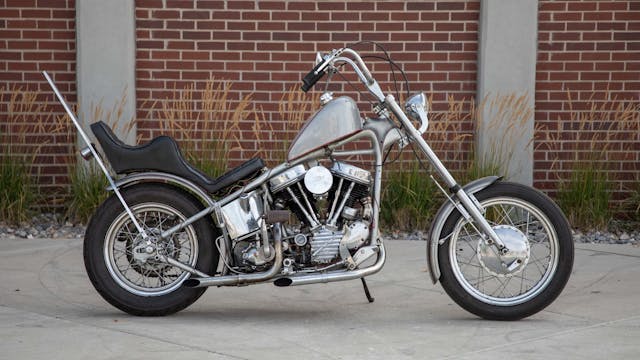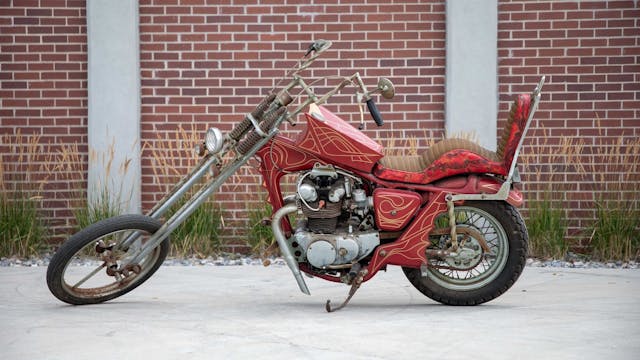These 5 choppers from the ’70s are cool enough to bridge generations
Hair and clothing styles rarely age well, but vehicle trends seem to fade only to return a few decades later. The latest evidence of this phenomenon? ’70s choppers.
Millennials have zero nostalgic connection to the ’60s and ’70s chopper craze and have no reason to reflect longingly on these highly stylized bikes. The absurd frame modifications and over-extended front forks are just the start with these custom jobs—consider the even wilder seats, handlebars, and paint work. Choppers don’t exactly showcase timeless elegance. Even so, ’70s choppers seem to resonate with generations born years after the fad passed.
As two young folks, Kyle Smith and I picked out five choppers from Mecum’s Las Vegas Motorcycle Auction that we think are ridiculous—and way cool.
1967 Triumph “Captain America”

Choppers scream Americana and Route 66, and the Harley brand goes with choppers like Hallmark goes with Christmas. A Triumph chopper might surprise you, especially one wearing a Captain America paint job; but once the bobber craze of the ’50s turned into the chopper craze of the ’60s and ’70s, anything counted as art, British bikes included. A few builders wouldn’t touch a British engine—and some still don’t—but the Triumph twins became almost as famous as Harley Panheads and Knuckleheads.
This 1967 Triumph chopper is a textbook example from How to Build a Chopper, first edition. King-and-queen seat? Check. Wider rear tire on a smaller rim? Check. Raked front end with springer forks? Check. Narrow ape bars? Check. Captain America paint job? Check.
We’d take it.
1948 Harley Panhead

This Panhead is worthy of an Easy Rider reenactment. A Triumph chopper is cool, but a Panhead crammed into a chopped frame looks even better. This example has a first-year ’48 Panhead, an engine that gets its name from the pan-shaped rocker covers atop the cylinder heads.
Prior to 1969’s Easy Rider, a flick that accelerated the chopper craze, Panhead engines were the “budget” V-twin option found on shop shelves or in the back corners of garages. Tim Graber, the owner of Classic Motorcycle Consignments, recalls that “Panheads at the time were old, used-up, and cheap to work with compared to the newly produced Shovelhead.” Once Easy Rider splashed the famous Billy Bike and “Captain America bike across the movie screen, however, Graber says that conservative riders came out of the closet. The Panhead choppers were seen as “absolutely beautiful, strong, and representing freedom.”
1953 Harley Panhead

This bike is the only one in this collection to feature a flat-sided “coffin” gas tank, and it also looks like a project in waiting. This chopper’s missing some pieces and doesn’t appear to have any brakes. Its extreme style might not resonate as much as the peanut tanks and king-and-queen seats of other choppers, but it exists in a niche of styles from years gone by.
On a happier note, the ’53 Panhead engine represents a nice upgrade from the 1948 engine. To improve reliability, Harley upgraded the Panhead’s oil pump, and the rockers, lifters, and valves were redesigned for better oil flow. Parts are fairly readily available for these bikes, making a spring ride possible if you stay focused all winter.
1949 Harley-Davidson Panhead

We know, we know—this is the third Panhead in a row, but the trio is a reminder that the Panhead was (and is) the iconic base for a chopper build. This particular one is both wilder and more tame than most: The paint is as out-there as you can get, but the front assembly is strangely understated. Our best guess? While the crazy 4–8-inch stretched front forks photograph well and look crazy on the street, they can make a bike a real handful to ride. This Panhead uses a stock frame and front end, meaning that its builder likely wanted a cool custom that wasn’t too demanding to ride.
1968 Honda CB450

Triumphs and Harleys get most of the love these days, but just about any ’70s bike could be the base for a custom. Builders used what they had, and that’s the reason why this CB450 twin is so far-out. The frame is nearly unrecognizable for the changes. Interestingly, the builder elected to replace the rear shocks with twisted and chromed solid metal. Choppers aren’t about comfort—but that just seems a bit excessive from where we sit.
Do any of these customs spark a bit of societal rebellion in you? If they do, maybe you should embrace that impulse and head to Mecum’s Las Vegas auction. Trends go in cycles, and choppers are on the return.
Like this article? Check out Hagerty Insider, our website devoted to tracking trends in the collector vehicle market.


i have the occ chopper bicycle 20in i modafide the complete bike it has a 50in long front end with a 18in front tire and a 20in rear fat tire. the frame is red and chrome with ared sportster tank.it has a bobber seat with a sissey bar. it has a 301cc preator motor. its fast.it has rear black leather saddle bags with front old style head light and a taile light.its a fine looking bike.
Might wanted to find someone who lived the 70’s, to pick representations of the era. Try looking at old issues of Easy Rider Magazine, for what people would actually ride. Some were beautiful, elegant, and easy to handle, because the ones riding them built them to ride. I rode Harleys, Honda Triump, BSA and Nortons, all chopped, but with neck modifications to make them also handle. These need work. a moderate extension, along with a mild rake, IMPROVES the handling instead of making it harder. Of course, anyone can get ridiculous and make a bike nearly impossible to ride. I rode a Norton chopper to Sturgis in the 70’s, a hardtail. Had to stop on the way back, via I 35 and let my kidneys quit bleeding. Thankful I was young!